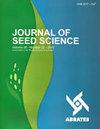总状花序和果实成熟对巨叶可可、费雷拉和格里贝尔幼苗出苗的影响
IF 1.2
4区 农林科学
Q3 AGRONOMY
引用次数: 0
摘要
摘要/ Abstract摘要:巨叶可可(Coccoloba gigantifolia)果实各总状花序成熟不均匀,影响种子质量。本研究旨在研究采收后的总状花序、果实和种子的特征,并评估种子在果实成熟阶段的生理表现。表征完成后,进行两个实验。首先,采用完全随机设计,采用4(总状花序)× 4(果实成熟阶段:绿色、半绿色、红色和紫色)的因子方案,4个重复。在第二个试验中,采用随机区组设计,采用4(果实成熟阶段)× 2(有和没有种子干燥)的因子设计,共4个重复。果实在每个总状花序内逐渐成熟,果实的颜色从完全绿色到完全紫色同时存在。在繁殖方面,应优先在半绿色、红色和紫色阶段收获果实较多的总状花序,因为绿色果实的种子生理质量较低。不同总状花序的种子除了出芽随果实成熟而变化外,还表现出不同的行为,这似乎与种子休眠水平的不同有关。本文章由计算机程序翻译,如有差异,请以英文原文为准。
Emergence of Coccoloba gigantifolia Melo, Cid Ferreira & Gribel seedlings as a function of raceme and fruit maturation
Abstract: Coccoloba gigantifolia fruits show uneven maturation within each raceme, which can affect the quality of the seeds. This study aimed to characterize racemes, fruits, and seeds, after harvest, and evaluate the physiological performance of the seeds as a function of the fruit maturation stage. After characterization, two experiments were set up. In the first, a completely randomized design was used, in a 4 (racemes) x 4 (fruit maturation stages: green, half-green, red, and purple) factorial scheme, with 4 replications. In the second, a randomized block design was adopted, in a 4 (fruit maturation stages) x 2 (with and without seed drying) factorial scheme, with 4 replications. Fruit maturation occurs progressively within each raceme, with fruits from completely green to completely purple in color existing at the same time. In propagation, preference should be given to harvesting racemes with a greater number of fruits in the half-green, red, and purple stages, since seeds from green fruits have low physiological quality. In addition to the variation in emergence as a function of fruit maturation, the seeds of the different racemes also showed different behaviors, which seems to be associated with different levels of seed dormancy.
求助全文
通过发布文献求助,成功后即可免费获取论文全文。
去求助
来源期刊

Journal of Seed Science
Agricultural and Biological Sciences-Agronomy and Crop Science
CiteScore
2.00
自引率
30.00%
发文量
28
审稿时长
12 weeks
期刊介绍:
From 2017 the Journal of Seed Science (JSS) will circulate online version only.
Original scientific studies and communications, not yet published or submitted to another journal for publication and written in Portuguese or English, will be accepted for publication. For manuscripts submitted in English, the authors should provide an adequated version.
The SCIENTIFIC COMMUNICATION is a category of scientific manuscript which describes a technique, an equipment, new species or observations and surveys of limited results. It has the same scientific rigor as the “Scientific Articles” and the same value as a publication. The classification of a manuscript as a SCIENTIFIC COMMUNICATION is based on its content and scientific merit but it can be a preliminary study, simple and not definitive on a certain subject, with publication justified by its uniqueness and contribution to the area.
The Editorial Board of the JSS may invite leading authors of recognized reputation to compose specific Review Articles covering topics of their specialization that will convey to the scientific community the state-of-the-art knowledge related to the specific theme.
 求助内容:
求助内容: 应助结果提醒方式:
应助结果提醒方式:


